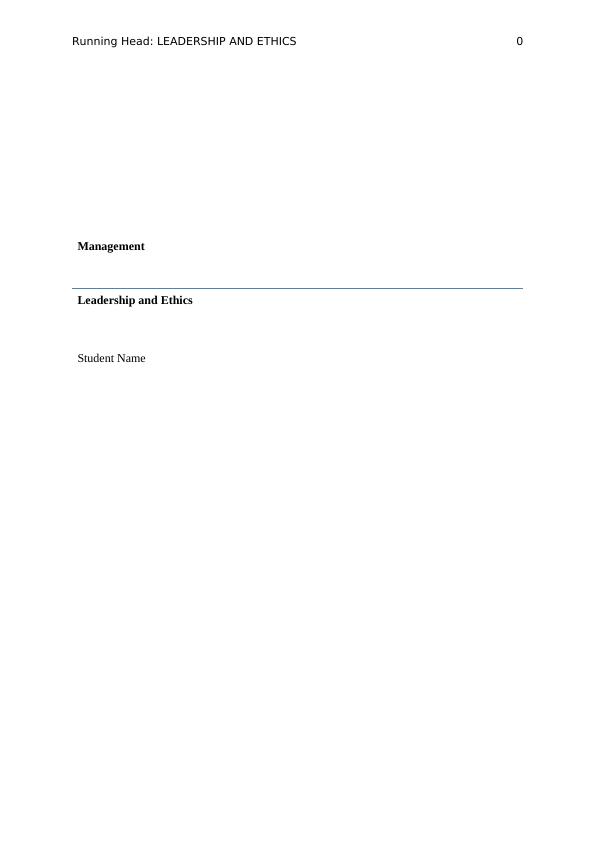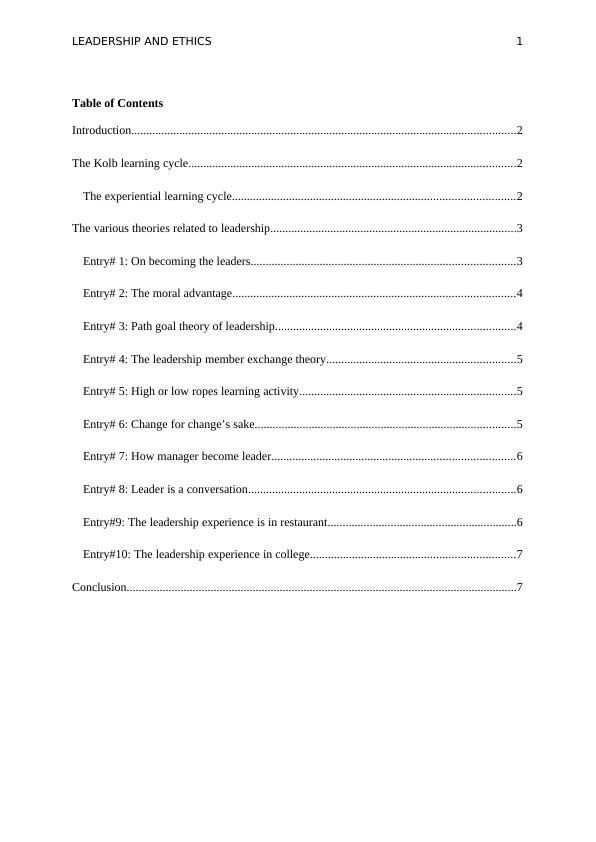Leadership and Ethics
Added on 2022-11-29
12 Pages3197 Words449 Views
Running Head: LEADERSHIP AND ETHICS 0
Management
Leadership and Ethics
Student Name
Management
Leadership and Ethics
Student Name

LEADERSHIP AND ETHICS 1
Table of Contents
Introduction................................................................................................................................2
The Kolb learning cycle.............................................................................................................2
The experiential learning cycle..............................................................................................2
The various theories related to leadership..................................................................................3
Entry# 1: On becoming the leaders........................................................................................3
Entry# 2: The moral advantage..............................................................................................4
Entry# 3: Path goal theory of leadership................................................................................4
Entry# 4: The leadership member exchange theory...............................................................5
Entry# 5: High or low ropes learning activity........................................................................5
Entry# 6: Change for change’s sake.......................................................................................5
Entry# 7: How manager become leader.................................................................................6
Entry# 8: Leader is a conversation.........................................................................................6
Entry#9: The leadership experience is in restaurant...............................................................6
Entry#10: The leadership experience in college....................................................................7
Conclusion..................................................................................................................................7
Table of Contents
Introduction................................................................................................................................2
The Kolb learning cycle.............................................................................................................2
The experiential learning cycle..............................................................................................2
The various theories related to leadership..................................................................................3
Entry# 1: On becoming the leaders........................................................................................3
Entry# 2: The moral advantage..............................................................................................4
Entry# 3: Path goal theory of leadership................................................................................4
Entry# 4: The leadership member exchange theory...............................................................5
Entry# 5: High or low ropes learning activity........................................................................5
Entry# 6: Change for change’s sake.......................................................................................5
Entry# 7: How manager become leader.................................................................................6
Entry# 8: Leader is a conversation.........................................................................................6
Entry#9: The leadership experience is in restaurant...............................................................6
Entry#10: The leadership experience in college....................................................................7
Conclusion..................................................................................................................................7

LEADERSHIP AND ETHICS 2
Introduction
The leader of the organisation is the person who leads an organization as well as gives
instructions to the employees and motivates them to do the right things in the favour of
organisation (Shapiro & Stefkovich, 2016). In addition, the action, which is taken by the
leader for leading the group, is known as leadership.
The ethical leadership includes the leader’s act, which are ethical and setting the standards for
others to do as well. This report is based upon various aspects of leadership such as Kolb
leadership cycle description and there is the explanation of learning’s from the situations like
the path goal theory, leader-member exchange theory, high & low hopes learning activity etc.
In addition, there is the discussion of articles from the HBR, based upon managers becoming
leaders, becoming the boss and so on. The last evaluate the issues and top related leadership
through experience or observation.
The Kolb learning cycle
It refers to the learning style model published by Kolb, as to develop the inventory
learning style (Konak et al., 2014). This theory is used to work for the two working
models, which have four styles in the theory, in which Kolb is concern about learner’s
internal cognitive processes. He also states that certain learning is the acquisition of abstract
Introduction
The leader of the organisation is the person who leads an organization as well as gives
instructions to the employees and motivates them to do the right things in the favour of
organisation (Shapiro & Stefkovich, 2016). In addition, the action, which is taken by the
leader for leading the group, is known as leadership.
The ethical leadership includes the leader’s act, which are ethical and setting the standards for
others to do as well. This report is based upon various aspects of leadership such as Kolb
leadership cycle description and there is the explanation of learning’s from the situations like
the path goal theory, leader-member exchange theory, high & low hopes learning activity etc.
In addition, there is the discussion of articles from the HBR, based upon managers becoming
leaders, becoming the boss and so on. The last evaluate the issues and top related leadership
through experience or observation.
The Kolb learning cycle
It refers to the learning style model published by Kolb, as to develop the inventory
learning style (Konak et al., 2014). This theory is used to work for the two working
models, which have four styles in the theory, in which Kolb is concern about learner’s
internal cognitive processes. He also states that certain learning is the acquisition of abstract

LEADERSHIP AND ETHICS 3
concepts, which implies or applies required flexibility in certain range of situations within the
organization. There are impetus new concepts are also developed, which provides new
experience to employees as well as the leaders.
The organization wants to implement new changes related to manufacturing of
products (Bergsteiner et al., 2010). The leader wants to follow his concepts and ideas, but
employees wants to get involved in this implementation. The Kolb states that first learning
should be made then, it require changes to be made in between the process of manufacturing
with concern all the employees of the organization.
The experiential learning cycle
It represents by the four learning styles of the theories, which touches all the aspects,
and on the bases of aspects the leader will implement the require changes need be made in the
organization (SUSAN & VALERIE, 2010). These changes should be implemented in the
company. The first level is concrete in which organization will encounter new experiences,
situation, or reinterpretation of existing experience. Second is reflective observation refers to
certain particular importance which are in between inconsistence experience and
understanding. Third is abstract refers to raising new ideas or modification in new abstract
and new concepts as the person has to learn from its new experience (McCarthy, 2010).
Fourth is active, in which leaders apply ideas, which are seen around the world or see what
happen in the organization.
The effective learning can be seen in between the employees when individuals go
through a cycle of four stages as discussed above. The four stages make the learning more
effective as well as strong, so that employees being more effective in the organization. The
learner is also viewed, that the employees have to undergo through the integrated process
with each stages, which are individually or mutually supportive as well as feeding into the
concepts, which implies or applies required flexibility in certain range of situations within the
organization. There are impetus new concepts are also developed, which provides new
experience to employees as well as the leaders.
The organization wants to implement new changes related to manufacturing of
products (Bergsteiner et al., 2010). The leader wants to follow his concepts and ideas, but
employees wants to get involved in this implementation. The Kolb states that first learning
should be made then, it require changes to be made in between the process of manufacturing
with concern all the employees of the organization.
The experiential learning cycle
It represents by the four learning styles of the theories, which touches all the aspects,
and on the bases of aspects the leader will implement the require changes need be made in the
organization (SUSAN & VALERIE, 2010). These changes should be implemented in the
company. The first level is concrete in which organization will encounter new experiences,
situation, or reinterpretation of existing experience. Second is reflective observation refers to
certain particular importance which are in between inconsistence experience and
understanding. Third is abstract refers to raising new ideas or modification in new abstract
and new concepts as the person has to learn from its new experience (McCarthy, 2010).
Fourth is active, in which leaders apply ideas, which are seen around the world or see what
happen in the organization.
The effective learning can be seen in between the employees when individuals go
through a cycle of four stages as discussed above. The four stages make the learning more
effective as well as strong, so that employees being more effective in the organization. The
learner is also viewed, that the employees have to undergo through the integrated process
with each stages, which are individually or mutually supportive as well as feeding into the

End of preview
Want to access all the pages? Upload your documents or become a member.
Related Documents
Human Resource Management - Personal and Management Skills Courselg...
|19
|4655
|17
Reflective Theories Report - Gibbs & KOLBSlg...
|7
|676
|150
Enhancing Learning Skills at University: Reflections and Future Challengeslg...
|6
|1481
|32
Preparing for Success At University - Knowledge and Creativitylg...
|6
|1472
|134
Reflection on Group Worklg...
|6
|1306
|41
Developing Personal and Management Skillslg...
|13
|3701
|36
